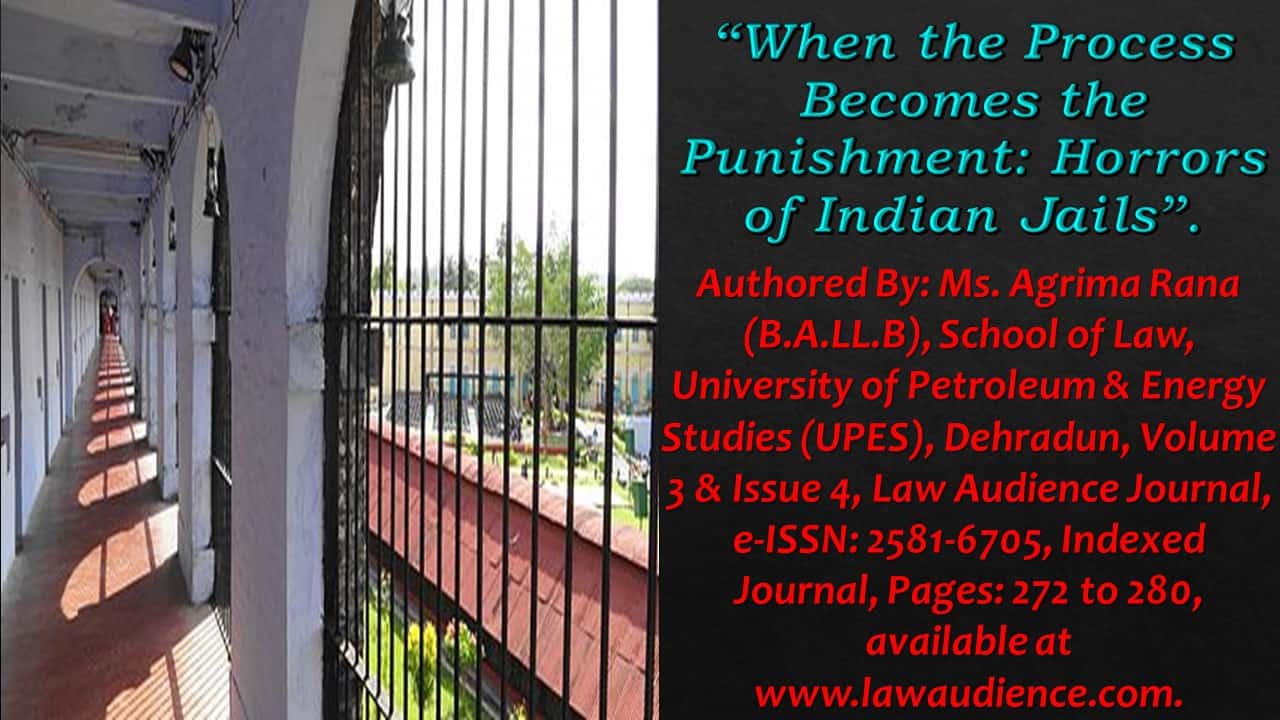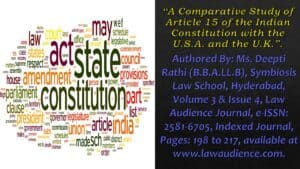Click here to download the full paper (PDF)
Authored By: Ms. Agrima Rana (B.A.LL.B), School of Law, University of Petroleum & Energy Studies (UPES), Dehradun,
Click here for Copyright Policy.
ABSTRACT:
Prisons have been envisioned as reformative care-giving institution in democratic systems. However, the reality of prisons includes overcrowding; inhumane living circumstances; a lack of basic requirements such as food, medical treatment, and hygiene; lack of administration accountability and transparency; targeting and monitoring, torture, and even death; and a lack of opportunity for skill development or entertainment. Is this really the case? For one thing, the fear of crime control and the rising targeting and otherization of people with specific socio-political connections are influencing society’s perceptions of how convicts should be treated. The new norm for good governance is to be tough on crime and impose the harshest penalties possible. Prisoners are a segment of society that is shunned, isolated, and rarely discussed. Additionally, no treaty establishes required rights for convicts, leaving it subject to shifting administrations and societal attitudes.
“India shares the widely accepted belief that a term of incarceration is only acceptable if it results in the protection of society from crime. Only jail can encourage and prepare a criminal for a law-abiding and self-supporting existence when he is released. It also recognises that, because imprisonment deprives the criminal of his liberty and autonomy, the prison system should not be permitted to exacerbate the pain already present during the incarceration process.”[1]
Keywords: Prisoners, Democratic System, Society.
I. INTRODUCTION:
The legislation governing offenders’ rights has progressed throughout time. It’s a disgrace that a country like India lacks a defined legislation on prisoners’ rights. In addition, there is no comprehensive legislation that addresses individuals’ rights and governs their conduct while incarcerated. The country’s court, on the other hand, has repeatedly accorded the prison officers proper respect and upheld their fundamental rights. It has managed to develop precedents and principles maintaining the numerous rights of prisoners in the lack of comprehensive law, which further advise but also obligate all Indian courts. Prisons have as their primary goal the reintegration of convicts back into society.
If a person commits a crime, it does not entail that he ceases to be a human being or that he is entitled to deprive himself of the qualities of life that define human dignity. He is still a human being who should be treated as such. He should be granted the same basic human rights as every other guy on the planet. However, he should not be regarded as a free man with all of life’s privileges. His liberty should be limited and regulated by the law. Additionally, these constraints must be rational.
This stance is the outcome of multiple Supreme Court of India judgements over the span of decades, in which the jail administration has been admonished for deplorable living situations and animal-like treatment of detainees. The United Nations’ Standard Minimum Rules for the Treatment of Prisoners also ask for prisoners to be treated with dignity so that they can be reintroduced into society, with no greater infliction of anguish beyond the captivity itself. Notwithstanding of their position as a detainee, undertrial, or guilty, the Supreme Court of India has said that a prisoner should be treated with respect and as a lawful person with rights.
As previously stated, prisoner rights are still evolving. From the case of Platek vs. Aderhold (USA),[2] in which the courts held that they had no authority to intervene with the behaviour of the jail or its rules and regulations, to Johnson vs. Avery, in which the court recognised certain rights of the convicts, the transition has been gradual. In the Indian context, the country’s judiciary has regularly utilised the Constitution’s Fundamental Rights to save inmates. The Supreme Court Judge Justice Krishna Aiyer decided in the landmark case of Charles Sobraj through Marie Andres vs. The Superintendent, Tihar Jail, that:
“imprisonment does not spell farewell to fundamental rights although, by a realistic re-appraisal, Courts will refuse to recognise the full panoply of Part III enjoyed by a free citizen”.[3] He further stated that the imprisonment of a prisoner is not merely retribution or deterrence but also rehabilitation.
II. THE DEPLORABLE CONDITION OF INDIAN PRISONS:
The pandemic has brought attention to appalling jail conditions that prevail in India. It is well known that the jail serves as a reflector of societal structure. To push this parallel further, the circumstances inside jails reflect the character of any democracy. By that standard, India needs some soul-searching. Not only has our disintegrating criminal justice system made a farce of swift trials, but it has also assured that undertrials languish in bars for decades due to slow and sometimes skewed (if not corrupt) investigations and prosecutions. Courts seldom intervene to guarantee comprehensive investigations and strong prosecutions, or to ensure that trials are completed within a reasonable amount of time.
What’s worse, that 70 percent of the 300,000 prisoners in India’s 1,356 jails have never been convicted of a crime. They are detainees, the majority of whom have been victims of police brutality and a painfully sluggish court system. Almost 2,000 of them have spent more than five years in prison without being convicted of any crime. When these results are compared to the country’s total conviction rate of only 6.5 percent, the system’s inequity becomes clear. The comorbidities in the Bhima Koregaon case are also present.[4] Which made the conditions more noticeable than before in some Indian jails, conditions are deplorable, with little or no oversight from groups mandated to do so. The conditions of the prisons have been worse but with times it’s getting vilest. It was said that not only the detainees, but even the guards, would be infected. According to reports, over 20 detainees in a Madhya Pradesh jail tested positive for Corona. After anticipating the pandemic, the World Health Organization advised jail administrators and governments in several nations to cut prisoner populations, citing the virus’s rapid spread. In this difficult period, two fundamental issues must be addressed: the infructuous Model Prison Manual, 2016 to deal with the pandemic, and the mental health ignorance of convicts. The Supreme Court directed the state government to look into the situation, and Chief Justice of India Sharad Arvind Bobde ruled that a committee should be constituted to categorise the detainees and determine which ones should be freed. Statistics were gathered. Which showed that about 12000 prisoners were released till April.
The Indian Constitution does not directly mention the rights of prisoners, but in the decision of T.V. Vatheeswaran vs. State of Tamil Nadu,[5] it was determined that both inmates and non-prisoners had rights under Articles 14, 19, and 21. Fundamental rights are not barred by prison walls. The state shall not deny any individual equality before the law or equal protection of the laws within the territory of India, according to Article 14 of the Indian Constitution. As a result, Article 14 examines the principle that “like should be treated alike” and establishes the idea of fair classification.[6] The Supreme Court has looked into the issue of inhumane treatment of inmates in prison and has issued orders. The Supreme Court has looked into the issue of inhumane treatment of convicts in prison and has issued orders in this regard. The right against cruelty was inserted into Article 14 and 19, and the top court further stated that any conduct that goes beyond a person’s dignity and is arbitrary can be challenged under Article 14.
III. ARTICLE 21, IT GRANTS YOU THE FOLLOWING PRIVILEGES:
Right To Personal Life, Privacy, and Liberty:
In Kharak Singh vs. State of UP [7], it was determined that Article 21 was the repository of residuary personal rights, and the right to privacy was recognised. It made it illegal to mutilate one’s body by amputation of an arm or limb or damage to any other organ through which one communicates with the outside world. In Kharak Singh vs. State of Uttar Pradesh, it was held that Article 21 was the repository of residuary personal rights, and thus the right to privacy was recognised. “Something more than just animal existence,” the Court said in Kharak Singh vs. State of U.P. (1964), while defining the term “life” under Article 21, “Something more than mere animal existence.” The resistance to its deprivation spreads to all of the limbs and faculties that allow us to enjoy life. The rule also forbids the amputation of an arm or limb, the removal of an eye, or the destruction of any other part of the body through which the soul communicates with the outside world.”
The right to live with human dignity, encompasses all parts of one’s life that make it meaningful, full, and worthwhile.[8] The 42nd Amendment Act of 1976, which includes Free Legal Aid as one of the Directive Principles of State Policy under Article 39A of the Constitution, demonstrates the judiciary’s concern for impoverished convicts. In Madhav Hayawadan Rao Hosket vs. State of Maharashtra, a three-judge panel of the Supreme Court examined Articles 21 and 39-A of the Constitution, as well as Article 142 and Section 304 of the Criminal Procedure Code, and decided that the government was required to offer free legal assistance to the accused.[9]
Right To Free Medical Treatment:
The petitioner was imprisoned in Central Jail and was suffering from a serious illness for which he was denied treatment. The negligent police officers were found to be accountable by the High Court.[10] Right to a rapid trial: The court concluded that the right to a timely trial is available to accused at all stages of the trial under Article 21. The accused’s right to a quick trial cannot be taken away simply because he did not request one.[11] The Supreme Court affirmed the imprisonment in AK Gopalan vs. State of Madras (1950), where the petitioner was imprisoned at Madras Jail under the Prevention Detention Act, 1950, and found that it did not violate article 21 since it was done according to “process established by law.” In the case of ADM Jabalpur vs. Shiv Kant Shukla (1976), the Court stated that the scope of life and liberty is suspended during an emergency. Furthermore, in the landmark decision of Maneka Gandhi vs. Union of India (1978), the Supreme Court expanded the meaning of ‘life’ under Article 12 and concluded that any state procedure must be equitable and reasonable. The Supreme Court has looked into the issue of inhumane treatment of inmates in prison and has issued orders in this regard. The right against cruelty was inserted into Article 14 and 19, and the top court further stated that any conduct that goes beyond a person’s dignity and is arbitrary can be challenged under Article 14.
STATUTE CONCERNING THE RIGHTS OF PRISONERS:
1894 Prisoners Act, One of India’s oldest jail statutes is the Prisons Act, 1894. The Act’s Chapter VII addresses prisoner employment concerns, stating that they may work with the superintendent’s permission and collect their wages, but that they must not labour for more than 9 hours each day. According to Section 37 of the Prisoner’s Act of 1894, if any prisoner is determined to be unwell, the officer in charge shall speak with the Jailer and immediately contact Medical Subordinate. Other provisions of the Act address whether Civil or under-trial inmates can obtain goods like as clothes, bedding, or food from outside the jail. The 1950 Prisoner Transfer Act, was enacted to allow for the transfer of prisoners. The act’s goal was to allow prisoners to be transported across Indian states for vocational training, to reduce overcrowding in jails, and to safeguard fundamental human dignity.
Against Cruel and Inhuman Treatment:
Every prisoner has the right to be free of any cruel or inhumane treatment. In various occasions, the Supreme Court of India has emphasised the harsh treatment of inmates and instructed state and jail officials to check and control the situation. The use of tools such as handcuffs, shackles, irons, and straitjackets in punishing the convicts was also outlawed by the court. Other forms of constraint are legal, but only under limited circumstances.
The following are the circumstances:
- Using restraint equipment as a precaution against escape during the transportation of detainees, provided that it is removed before the prisoner is brought before an administrative or judicial authority.
- If the medical officer approves it for medical reasons;
- When deterring a prisoner from self-harming or damaging property is difficult, the director, in collaboration with the medical officer, and after reporting to the higher administrative authority, may order the prisoner to be placed in restraint equipment.
- The central jail administration will decide on the patterns and mode of use of restraining tools. Such tools should only be used for as long as they are absolutely necessary.
The petitioners in Sunil Gupta vs. the State of MP[12], had voluntarily surrendered themselves. They even refused to be released on bond, instead to remain in prison for the greater good. Despite the fact that they were handcuffed and escorted to court by the escort party. The court stated that the escort party’s actions were inhumane and in violation of Article 21 of the Constitution. The court also ordered the government to take fast and proper measures against the defaulting escort portion for handcuffing the inmates in an unlawful and unreasonable manner.
In the case of Kadra Pehadiya vs. the State of Bihar[13], the court voiced its displeasure at witnessing four petitioners shackled in leg shackles while awaiting their trial. The court determined that such actions are flagrant breaches of all prison laws as well as the standards established by the court in Sunil Batra’s case. Following that, the court ordered the Superintendent to remove the four petitioners’ leg shackles as soon as possible. The court further ordered that no criminal or under-trial detainee be placed in leg irons until the ratio of Sunil Batra’s case ruling be followed.
IV. SUGGESTIONS:
- There are 1387 prisons in India, with a total capacity of 3,66,781 inmates; however, certain states have more than double the number of convicts than available space[14].
- The government could expand capacity; the judiciary can help by not delaying judgements; and open jails might be a viable solution to congestion.
- The issue may be handled at an international level, and jail officials should take care of it. A special committee should be formed within the prison to oversee this and ensure that the regulations are followed.
- Implementation of a Jail Welfare Scheme that would assist them not just while in prison but also when they are released. Wallowing prisoners in productive activity such as creating carpets, khadi clothing, vases, and miniature temples, which will help them grasp the value of work while also keeping them away from heinous acts, leisure amenities like as yoga instruction, vocational training, painting, and job placement should be offered so that they may begin their new lives with dignity.
V. CONCLUSION:
While they are incarcerated, prisoners are entitled to all of their fundamental rights. Although the Indian Constitution does not directly guarantee the rights of prisoners, Articles 14, 19, and 21 implicitly do so, and the Prisons Act of 1894 has measures for the comfort and protection of inmates. When constitutional rights or statutory prescriptions are violated to the detriment of a prisoner, the Court has declared that it has the authority to intervene with prison management.
In various situations, the Supreme Court has ruled that a prisoner is a human being, a natural person, and a legal person. He remains a human being, a natural person, and a legal person when incarcerated. Prisoners cease to be human beings too, and the Supreme Court has reiterated this position in numerous cases, recognising the rights of prisoners so that they do not suffer and that a better rehabilitative environment is provided to them so that they can improve and become better human beings while serving their sentence. Conviction for a crime does not turn a person into a non-person whose rights are subject to the whims of the jail administration, therefore any severe penalty imposed inside the prison system is contingent on the absence of procedural protections.
Not only do state and federal governments have a responsibility to provide infrastructure, manpower, and humane circumstances for the rehabilitation and lawful survival of inmates, but they also have a responsibility to offer prisoners with timely knowledge about their rights in order to prevent conceivable, prospective, and extreme abuse of prisoners by strong inside the institutions. Munna Bajrangi’s assassination at Varanasi Jail is just the tip of the iceberg in terms of prisoner abuse. Thousands of examples of inmates’ rights breaches in jails go unchecked in India.
To sum up, I believe that providing inmates with knowledge about their rights, widespread media coverage of prisoners’ rights, and round-the-clock surveillance in prisons might be the keys to protecting prisoners’ rights in India.
Cite this article as:
Ms. Agrima Rana, “When the Process Becomes the Punishment: Horrors of Indian Jails”, Vol.3 & Issue 4, Law Audience Journal (e-ISSN: 2581-6705), Pages 272 to 280 (20th April 2022), available at https://www.lawaudience.com/when-the-process-becomes-the-punishment-horrors-of-indian-jails/.
Footnotes & References:
[1] According to the 2016 policy, the latest one, published by Government of India regarding prison management in the form of Model Prison Manual 2016, a “Perspective” chapter from the manual states.
[2] Nos. 7264, 7557.
October 23, 1934.
[3] 1975 SC 164, 1975 CriLJ 182, (1975) 1 SCC 192, 1975 (7) UJ 50 SC.
[4] https://srdefenders.org/india-inhumane-prison-conditions-for-bhima-koregaon-human-rights-defenders-joint-communication/.
[5] 1983 AIR 361, 1983 SCR (2) 348.
[6] Chowdhury Roy Nitai, “Indian Prison Laws and Correction of Prisoners”, Deep and Deep Publications 2002, p.75.
[7] 1963 AIR1295, 1964, SCT(1)332.
[8] Jeeja Ghosh v. Union of India (2016)7 SCC 761.
[9] 1978 AIR 1548, 1979 SCR (1) 192.
[10] Rasikbhai Ramsing Rana V. State of Gujarat 1999 CriLJ1975, (1999) 1GLR 176.
[11] AR Antulay v. BS Nayak 1988 AIR 1531, 1988 S CR Supl. (1).
[12] 1990 SCR (2) 871, 1990 SCC (3) 119.
[13] Kadra Pahadiya And Ors. Etc vs State of Bihar Etc on 19 March, 1997.
[14] https://qz.com/india/1743852/overcrowded-indian-prisons-are-understaffed-underfunded/.




